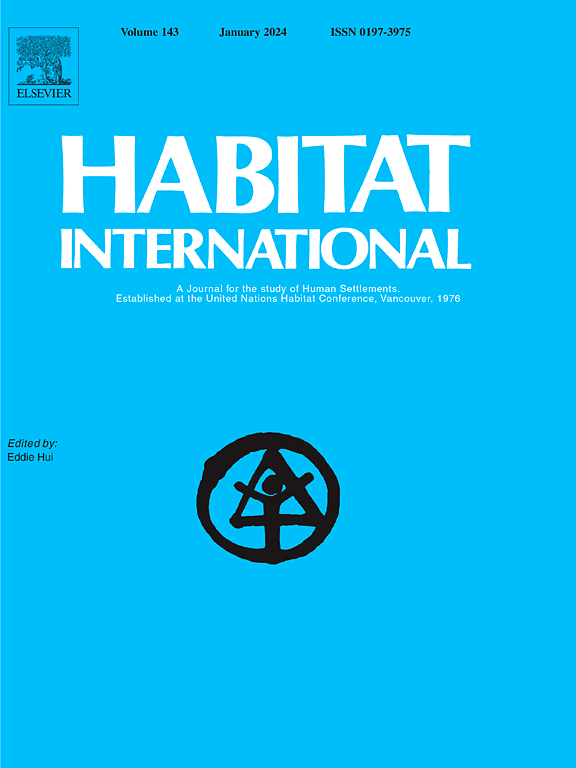Optimizing vertical urban development: The role of a multidimensional assessment framework for balancing vertical growth and habitability
IF 6.5
1区 经济学
Q1 DEVELOPMENT STUDIES
引用次数: 0
Abstract
Rapid urbanization and population growth have driven vertical urban development in densely populated cities facing land scarcity. However, such pursuit towards high-density living often compromises the quality of the built environment and habitability, and accurately assessing its impacts is challenging, making it difficult for urban planners to identify optimal vertical growth strategies. Here we present a comprehensive assessment framework that integrates detailed 3D urban landscape models with Computational Fluid Dynamics (CFD) to multidimensionally assess customizable factors such as ventilation, thermal comfort, air quality, sunlight exposure, and urban aesthetics under different vertical growth scenarios. The framework is demonstrated through a case study to guide the vertical growth in a new development area in Hong Kong. Our simulations show that high-rise building clusters pose challenges such as strong winds, and trapped heat and air pollutants, but well-designed configurations of tall, slim buildings with adequate spacing can harness wind flow to improve thermal comfort and air quality. Despite a general deterioration of habitability being observed as vertical growth increases, there exists a threshold below which habitability is less impacted. This observation enables us to develop a Vertical Urban Habitability Index (VUHI) that can determine the optimal vertical growth by quantifying the trade-offs between increasing building areas and maintaining environmental habitability. The result shows that relaxing building heights by 7–13 % and plot ratios by 26–32 % beyond the government's benchmark can optimize urban development without compromising habitability. This framework not only serves as a reliable tool to guide vertical urban planning, but also facilitates benchmarking the habitability of different vertical cities, which enables knowledge sharing and identifies best practices for sustainable vertical development worldwide.
优化垂直城市发展:多维评估框架对平衡垂直增长和宜居性的作用
快速的城市化和人口增长推动了人口密集、土地稀缺的城市垂直发展。然而,这种对高密度生活的追求往往会损害建筑环境的质量和可居住性,并且准确评估其影响是具有挑战性的,这使得城市规划者难以确定最佳的垂直增长策略。在这里,我们提出了一个综合评估框架,该框架将详细的3D城市景观模型与计算流体动力学(CFD)相结合,以多维度评估不同垂直增长情景下的可定制因素,如通风、热舒适、空气质量、阳光照射和城市美学。透过个案研究,示范该架构如何指引香港新发展区的垂直发展。我们的模拟表明,高层建筑群带来了强风、热量滞留和空气污染物等挑战,但设计良好的高层建筑配置和适当的间距可以利用气流来改善热舒适和空气质量。尽管随着垂直增长的增加,可居住性普遍恶化,但存在一个阈值,低于该阈值,可居住性受到的影响较小。这一观察结果使我们能够开发一个垂直城市宜居指数(VUHI),该指数可以通过量化增加建筑面积和保持环境宜居性之间的权衡来确定最佳垂直增长。结果表明,在政府基准的基础上,将建筑高度放宽7 - 13%,将容积率放宽26 - 32%,可以在不影响宜居性的情况下优化城市发展。该框架不仅是指导垂直城市规划的可靠工具,还有助于对不同垂直城市的可居住性进行基准测试,从而实现知识共享,并确定全球可持续垂直发展的最佳实践。
本文章由计算机程序翻译,如有差异,请以英文原文为准。
求助全文
约1分钟内获得全文
求助全文
来源期刊

Habitat International
Multiple-
CiteScore
10.50
自引率
10.30%
发文量
151
审稿时长
38 days
期刊介绍:
Habitat International is dedicated to the study of urban and rural human settlements: their planning, design, production and management. Its main focus is on urbanisation in its broadest sense in the developing world. However, increasingly the interrelationships and linkages between cities and towns in the developing and developed worlds are becoming apparent and solutions to the problems that result are urgently required. The economic, social, technological and political systems of the world are intertwined and changes in one region almost always affect other regions.
 求助内容:
求助内容: 应助结果提醒方式:
应助结果提醒方式:


